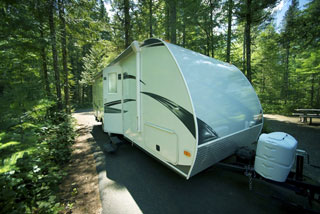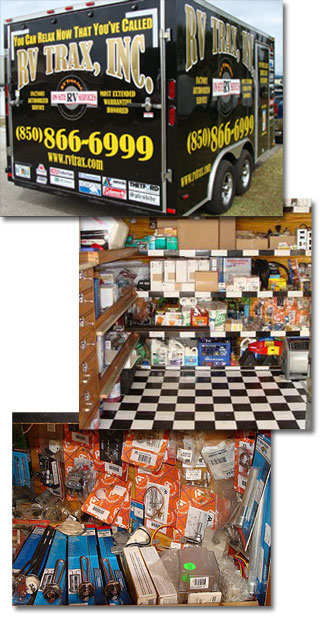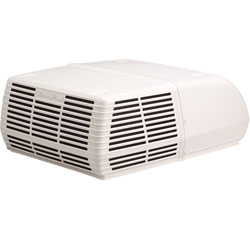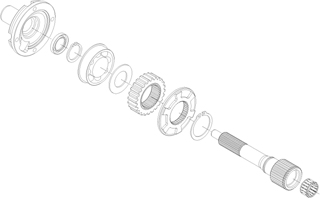PILOT MODELS
If your pilot model water heater is not operating properly, first check if the stove or other gas accessories are working, to verify proper gas operation. Sometimes these units have an air lock that will require an extended pilot lighting procedure. The gas valve being turned off for an extended period of time or an LP tank that has been removed to be refilled usually causes this. The pilot models use a gas control valve, burner and a thermocouple. The thermocouple, which senses the pilot flame, is a very small tube that runs from the lower portion of the gas control valve to a bracket located at the pilot flame. If the pilot lights when the gas valve is pressed but goes out when the gas valve is released, it may not be inserted into the pilot flame properly or the thermocouple is defective. Another common problem is that the ECO (Emergency Cut Out) has failed.This will require that the entire gas valve be replaced. There are other tests that can be performed by a qualified technician.
DSI MODELS
“Atwood” and “Suburban” are the two manufacturers of DSI (Direct Spark Ignition) water heaters in the RV industry today. There are only minor differences between the two. It would be difficult to get into specific detailed technical troubleshooting and repair techniques. We will answer some common questions and complaints that the average RVer can easily address. DSI models require a good 12-volt DC power source to operate. For details, see the article “Battery Maintenance”. Check the monitor panel for good supply voltage. Also, verify that the fuse for the water heater is good. The second test is to check if the stove or other appliances are operating to verify proper LP gas operation. For additional information see the article “Propane Gas Basics“. If these tests pass, check the following:
1. Always turn off the 110 Volt AC water heater switch or circuit breaker, if equipped with electric operation before servicing any water heater.
2. Unplug the electrical connector to the DSI Module Board and inspect the terminals for corrosion, then clean if necessary. Reinstall the connector. This board is usually black in color. Depending on the model, it can be located outside under the water heater cover or inside behind the water heater inside a cabinet, with a plastic cove rover the module if located inside.
3. All water heaters use a thermostat and an ECO (Emergency Cut Out) or high limit switch. Some models use a reset switch and can be reset by simply pressing the black rubber push button or a small pin type button located on the ECO switch. Some models also use a heat fuse that has a terminal on each end inside a clear plastic tube and can fail.
4. DSI models have a switch and a red light for LP gas operation located inside the RV. On most models the light should turn on momentarily until the water heater is lit. On all models if the light comes back on or stays on, this indicates a lock out problem and the unit will not operate. If this occurs, turn the switch off and back on to see if it is operating properly. This can be tried several more times. Air that may be in the LP gas system should self-bleed with this process. Air in the LP gas system can enter when the LP tank valve is closed for an extended period of time or the LP tank
has been refilled. If your water heater still will not operate, seek professional assistance.
Some important tips to follow for all models are:
1. Never operate your water heater in gas or electric operation if the tank is empty. To properly fill your tank, open a hot water faucet, with a pressurized water supply connected, until all of the air has escaped and clear water flow is present. Do not open the T&P valve to fill.
2. You should drain the water heater monthly to flush out corrosion. Turn off the water heater and supply before removing the drain plug. Open the T&P valve lever located on the top exterior of the water heater, this will aid in faster drain time. Always snap this valve closed and reinstall the drain plug before refilling the tank. Some models use an anode rod as part of the drain plug. This rod should be replaced if it is more than 50% deteriorated. Open a hot water faucet to refill the water heater.
T & P VALVE
This is a temperature and pressure safety valve. It is designed to release water pressure if the water temperature exceeds 210°F or if the pressure within the tank exceeds 124 to 150 PSI. Weeping or dripping at the valve while heating does not necessarily mean that the valve is defective. All water heater tanks require an air gap because water expands as it is heated. Never open the lever on the T&P valve to fill the tank. If the valve is leaking, turn off the water heater, water supply and allow cooling time to avoid burns. Remove the drain plug and open the T&P valve lever to aid in
quicker draining of excess water in the tank. Reinstall the drain plug and snap the T&P valve lever closed. Turn on the water supply, open a hot water faucet to expel all the air until clear water flow is established. Turn the water heater back on. If the leak reoccurs the T&P valve must be replaced.
SOOT
You should occasionally check the exhaust and flame of your water heater while operating in the LP gas mode. Always check this if your unit has been in storage. The flame can be seen when the exterior cover is opened and it should be a nice blue color. If the flame is yellow or orange, the water heater should be shut off immediately in the LP gas mode. It can still be operated in the electric mode. A common cause of an orange or yellow flame is a spider web or obstruction in the burner tube. Other causes are, a dirty orifice, restricted flue tube, misaligned burner, flame spreader, obstructed
exhaust grill or an improper air adjustment. Most RVers do not have the proper training or tools to address these concerns. You should seek professional assistance to correct the problem.
ROTTEN EGG SMELL
Some RV’ers have complained about a rotten egg smell in the hot water. It is most commonly caused by sulfur in the water. It can also be caused by an electro-galvanic action of the water heater tank or even the anode rod. Bacteria can also cause this. The best process to correct this condition is as follows:
1. Turn off the water heater and water supply. Allow cooling to avoid burns. Releasethe water pressure by opening a hot water faucet then close after the pressure is released.
2. Drain the tank by removing the drain plug. Open the T&P valve lever to aid in draining. Once it has drained, snap the T&P valve lever closed.
3. Turn on the water supply and allow plenty of clean pressurized water to flush the sediment out of the tank drain. Compressed air can also be used to agitate the sediment or in severe cases, you may also use a stiff wire through the drain hole to break up the sediment. Be careful not to damage the threads. Reinstall the drain plug when completed. Refill as outlined above, or continue to step 4.
4. Flush the entire system as described in the article WATER SYSTEM SANITATION.
5. For major smells, you can add 2 parts of distilled vinegar to 1 part water. This takes a lot of distilled vinegar. To do this reinstall the drain plug and open a hot water faucet to vent. Screw or install a rubber hose into the T&P valve with the lever open and insert a funnel into the open end of the rubber hose. Pour the vinegar and water solution through the funnel until the tank is full. Let it soak for at least 2 hours.
6. Remove the drain plug to drain all the solution from the tank. Snap the T&P valve lever closed and turn off the hot water faucet. Turn on the fresh water supply, and allow plenty of water to flush out the solution from the tank. Turn off the water supply, reinstall the drain plug, and open a hot water faucet. Turn on the water supply and allow all air to escape from the faucet until clear. Turn the water heater back on.
We have tried to address many of the common problems associated with water heaters. You should be aware of your own capabilities. This article is not intended to take the place of professional detailed technical training. If you would like to have a qualified professional correct these problems, call (850) 866-6999 or visit .





